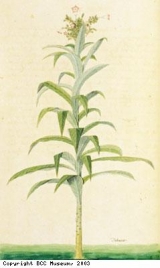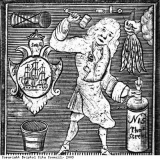Plantation tobacco
Tobacco became an important crop grown on the slave plantations in the 17th century. The southern states of America, such as Virginia, were the main areas growing tobacco, with small amounts grown on the Caribbean islands. In the 18th century, Bristol was an important processing centre for the tobacco that was imported from the plantations. The tobacco would arrive as dried leaves and would be processed into a twist, or rope, or as snuff. Eventually Glasgow overtook Bristol in processing tobacco in the 19th century, although Bristol remained a major tobacco city until the 1970s. Snuff is a powdered form of tobacco, which is sniffed instead of smoked. Mills were used to process the dried tobacco leaves from the Americas into snuff.The mills were built next to rivers as they used water-power to run the machinery.
Tobacco was found in the Americas, and was developed from a wild plant into a crop to be grown on plantations. The name, tobacco, is an American Indian word (the American Indians had settled in the Americas thousands of years before the Europeans arrived). The tobacco plant is an annual, that is it must be grown from seed each year. It was grown in Gloucestershire, in the west of England, for about 100 years, until it was banned in 1660. The ban was to protect the English merchants who had put money into the American tobacco industry. The Society of Merchant Venturers (a Bristol-based merchants’ society) had members with investments in the American trade. They campaigned for the ban on the local industry.
Like sugar, tobacco when first imported into Europe was rare and expensive. The government also heavily taxed it. Plantations producing tobacco grew in number. This meant that an increasing amount of tobacco was being imported into Europe. The smoking of tobacco or the taking of snuff (another form of tobacco which was sniffed as a powder instead of smoked) became an affordable habit for most people. Shown here is a tobacco wrapper. On it is a picture of a tobacconist making snuff by grinding tobacco into a bowl.
Some of the tobacco imported into Bristol was immediately exported to somewhere else. Pictured here is a ‘bill of lading’, which is a document (like a receipt) recording what is being loaded onto a ship. This bill of lading shows the loading of barrels of tobacco in Bristol for export to Dublin. The tobacco was being shipped by a merchant called Noblet Ruddock, who had many trading interests. He invested in the trading of slaves and he dealt in slave-produced goods such as sugar and tobacco. The bill of lading for his ship shows the tobacco leaving to go to Dublin after arriving in Bristol from the Caribbean.
It was not just Europeans who used tobacco. In 1526 Gonzalo Fernandez de Oviedo y Valdes, a Spanish writer, wrote that the enslaved Africans in the Americas ‘say that if they take tobacco when their day’s work is over they forget their fatigue’. This shows that the enslaved Africans who were working on the plantations were also using tobacco. The Rev. John Lindsay, a minister of the church in Jamaica, wrote in 1720 about tobacco, that “This Plant … is pretty much planted by the Negroes for the use of the Pipe; to which the Negroes are greatly inslaved. Indeed they alledge that this alone is what make their other Slavery the more tolerable”. The minister is reporting the slaves’ claim that the use of tobacco, which is a drug, made their lives as slaves easier to tolerate.





